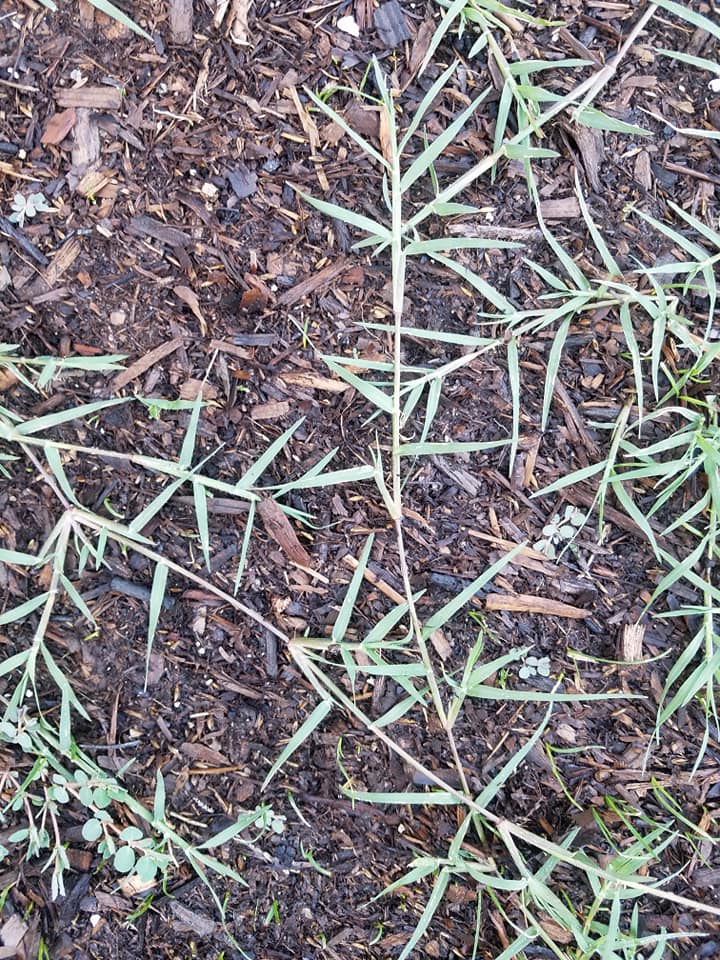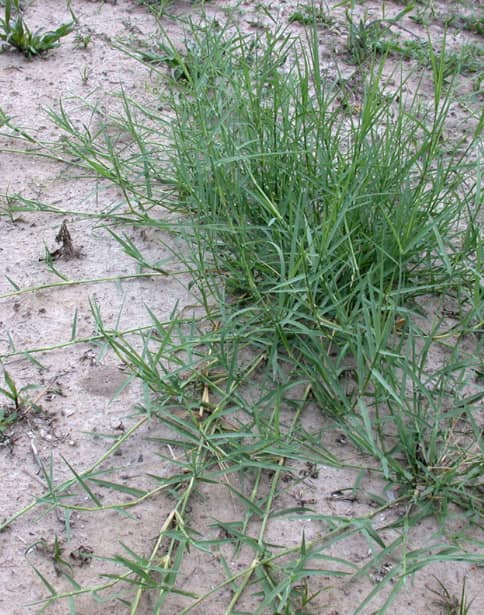Bermuda Grass can be a dream lawn grass, especially in hot climates and areas subjected to heavy foot traffic. On the flip side, it’s a relentless weed that’s a bane to many homeowners since it spreads aggressively.
Bermuda Grass is not just invasive but depletes soil nutrients, chokes out desirable plants, and can ruin the aesthetics of your landscapes. So, getting rid of it makes sense, but how?
We’ve got you covered. This guide contains ways to effectively remove Bermuda Grass and keep it from returning.
How To Get Rid Of Bermuda Grass
1. Dig Out Bermuda Grass
I won’t sugarcoat this: digging out Bermuda grass isn’t an easy task, especially on a large area or a sprawling lawn. Therefore, it’s best to use this approach only when dealing with a small patch of Bermuda grass.
The upside is while labor-intensive, this approach is highly effective and eco-friendly. For successful physical removal of Bermuda grass, ensure you take out all the parts, including the rhizomes and stolons, to prevent regrowth.
Moist, loose soil is easier to work with, so dig out the grass after rain or water the area first. Start digging from the edges, then work your way inward. Also, dig deep (at least 6 inches) because Bermuda grass rhizomes grow deep in the soil.
After digging up all the Bermuda grasses, bag and discard them properly. Inspect your garden or lawn weekly for regrowth (you may have to dig up the grass multiple times before fully eradicating it).
Read More:
2. Solarization
This next approach is among the least labor-intensive methods of removing Bermuda grass. Solarization is best suited for killing Bermuda grass in places devoid of other plants. It is most effective during the peak of summer.
What I love most about solarization is that it kills all the parts of the grass— those above the surface, underground stolons, and seeds. How does solarization work?
Solarization involves placing clear plastic over the ground to trap heat. This raises the soil temperatures to levels lethal to many plants, weeds, and pathogens. The temperatures can get to 140°F (60°C) or even higher.
How To Solarize Bermuda Grass
- Cut the Bermuda grass short.
- Remove large debris to make laying the plastic easier.
- Water the area thoroughly.
- Spread the plastic over the area, making sure you cover the whole Bermuda grass patch.
- Pin the plastic firmly to the ground by placing rocks, bricks, or stakes on the edges.
- Wait for 6-8 weeks for the grass to die.
- Remove the plastic and then rake out the dead Bermuda grass and other plant debris.
3. Smother Bermuda Grass
As a warm-season grass, Bermuda grass grows best in full sun, often needing at least 6 hours of direct sunlight daily to maintain its health and vigor. Depriving it of this vital requirement can kill it. But how do you do that?
Choking out Bermuda grass is best done with landscaping fabric, cardboard, or newspapers.
Landscaping Fabric
- Cover landscaping fabric over Bermuda grass.
- Weigh the fabric down by spreading gravel, sand, or mulch over it.
- Monitor the area periodically to ensure no Bermuda grass is trying to break through.
- Leave the fabric in place until all Bermuda grass dies. The time it takes to kill the grass varies based on its initial health and weather conditions.
Cardboard Pieces
- Mow the Bermuda grass to reduce its density.
- Cover the area with a compost layer (1/2 an inch thick) to spark biological activity.
- Create a thick layer of cardboard by flattening and stacking two cardboard boxes.
- Lay the cardboard over the affected area and anchor it with sod staples.
- Wet the cardboard and apply mulch over the area.
- Leave the area untouched for up to 4 months to ensure all the grasses get smothered.
Newspapers
- Mow the grass.
- Spread a layer of newspaper (10-sheet-thick) across the Bermuda grass. Ensure the newspapers overlap each other by a couple of inches.
- Spread mulch on top (6 inches thick) and wait for the grasses to die.
4. Dehydrate Them
You can weaken and eventually kill Bermuda grass by cutting its access to water over a prolonged period. Avoid watering the areas where Bermuda grass is growing during dry weather spells. Although this grass is tolerant to drought, prolonged exposure to heat and water deprivation leads to stress and, eventually, death.
Besides not watering your Bermuda grass, plow and break up the soil with a garden spade or rototiller. Dig into the ground deep (at least 6 inches) enough to turn over the soil and expose the roots and stolons of Bermuda grass to sunlight. This will expedite the drying process.
Cultivate the area every fortnight until you completely kill this stubborn grass.
5. Kill Bermuda Grass With Vinegar
Vinegar has herbicidal properties (acetic acid) that make it an effective weed killer. Consider using vinegar to kill Bermuda grass, especially if you prefer a natural approach; the solution will alter its pH and dehydrate it.
Household vinegar isn’t strong enough to kill Bermuda grass, so get horticultural vinegar. Spray the grass during a warm, sunny day, thoroughly covering the stems and leaves with vinegar. Bermuda grass will die within a few hours to a couple of days.
You will likely need to apply vinegar multiple times to completely eradicate Bermuda grass, especially in thick or well-established patches. Take caution when using vinegar because this weed killer is non-selective, meaning it kills any plant it touches, including your desirable plants.
While vinegar does a great job of burning the leaves and stems, it doesn’t kill the roots or rhizomes. This means the Bermuda grass can regrow.
6. Boiling Water
If you pour boiling water directly on Bermuda grass, it causes thermal shock, which damages the cells of the grass, causing dehydration and death. This method is most effective on younger plants and offers results immediately.
Besides killing the top parts of the Bermuda grass, boiling water will also penetrate the soil and dry out the roots. Carefully pour boiling water evenly and slowly directly on the Bermuda grass, focusing on the roots and blades.
The grass will wilt and brown out within a few hours. Once that happens, dig out the dead Bermuda grass. If the first application doesn’t work fully, repeat it.
7. Apply Herbicides
You may want to give herbicides a chance if the non-chemical methods fail to kill the Bermuda grass in your garden or lawn. Herbicides are also ideal if you want a fast approach to eradicating this grass and when dealing with a large patch.
Non-Selective Herbicides
It is best to use it in areas without desirable plants or if you want complete vegetation eradication because non-selective herbicides kill all the plants they touch.
Use Glyphosate herbicide to kill Bermuda grass in your lawn. Glyphosate kills many grass weeds and has a minimal residual effect. Glyphosate inhibits plants from producing the proteins they need to grow. This herbicide works systemically, entering the leaves and moving up to the roots.
You can also kill Bermuda grass with Diquat herbicide. This contact herbicide kills plants upon contact. It offers fast results but doesn’t kill the roots, so there’s room for regrowth.
Grass Selective Herbicides
These herbicides are formulated to kill the target grass species, in our case, the Bermuda grass, without harming non-grassy plants, like broadleaf plants and ornamental plants. Depending on the formulation, grass-selective herbicides target the different stages of grass growth or their metabolic pathways.
Examples of selective herbicides you can use to kill Bermuda grass are Quinclorac and Fenoxaprop-p-ethyl.
Application Tips For Herbicides To Kill Bermuda Grass
- Apply the herbicide on a dry, calm, non-windy day. Avoid rainy or windy days because they can cause chemical wash away or drift off.
- Lightly water the grass a day or two before application.
- If the herbicide needs to be diluted, follow the directions provided.
- Mow the grass. Cutting the grass short helps ensure the herbicide comes into contact with more grass.
- Spray the herbicide directly on the grass. Go for an even application, but don’t over-saturate it.
- Protect desirable plants from herbicide drift using barriers like tarps.
Note
The downside of using herbicides to kill Bermuda grass is that the chemicals can negatively impact the ecosystem, including beneficial insects, soil health, and nearby plants. Moreover, if the pesticides leach into water systems, they will cause contamination.
How To Prevent Bermuda Grass
- After successfully getting rid of Bermuda grass, take action to ensure it doesn’t grow back.
- Inspect your lawn and garden regularly and hand-pull any new growth as soon as you find it.
- Keep your lawn healthy by growing the right grass, mowing regularly, watering appropriately, and nourishing the lawn with a balanced fertilizer.
- Mulching makes the return of Bermuda grass difficult because it creates a barrier to resources necessary for regrowth, such as water, air, and light.
- Grow groundcovers in areas without turfgrass.
- Use pre-emergent herbicides to stop germination.
- Install edging around your garden beds and lawn.
Wrap Up
Bermuda grass is notoriously stubborn, hard to kill, and often grows where you don’t want it, so you must persist with your efforts to eradicate it. Also, you may have to combine multiple methods to ensure every part of the grass dies and doesn’t regrow.

Hey there, I’m Derek Schew, a writer for Lawnholic.com, where we cover everything and anything related to lawns. As someone who’s spent countless hours tending to my own lawn, I’m passionate about sharing my knowledge and helping others achieve the perfect yard. From lawn care tips to product reviews, I’m committed to providing our readers with the most accurate and up-to-date information available. So whether you’re a seasoned lawn enthusiast or just getting started, I invite you to join our community and discover the joys of a lush, green lawn.


